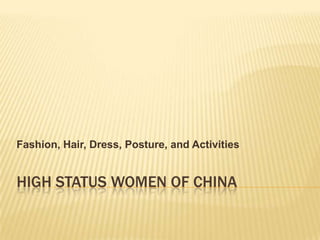
China women of high status
- 1. HIGH STATUS WOMEN OF CHINA Fashion, Hair, Dress, Posture, and Activities
- 2. “Some of these compositions accurately reproduce Tan-period conventions for grouping figures, a repertoire of common poses and actions and even some detail of Tang fashion” (pg. 211). In other words, these works of art help define the customs and fashion that took place in ancient Chinese times, although this quote specifies on the Tang dynasty, this could also be true for other ancient dynasties artworks of China.
- 3. THE TANG DYNASTY The Tang dynasty is known to characterize “Tang-style elegance and high fashion” (p. 211). Clothes were “elegant, noble, poised, and forever unique and amazing” (High status women in Tang dynasty were both privileged and pampered). Scene 1
- 4. Scene 2
- 5. Scene 3
- 6. LIFESTYLE The royal women of the Tang dynasty were said to have no restrictions or constraints when it involved marriage (Jianying, 2001). “Tang women was obviously quite different from that of the women of former dynasties…they could drink wine…conducted social activities and carried on business independently” (Jianying, 2001). They had active roles in elite family and court life (pg. 156). They had differing social norms from the Han dynasty because they had more freedom outside the household. They also had public lives and were able to engage in society along with a wider range of activities (pg. 156).
- 7. With Emperor
- 9. Empress Wu Zetian Empress Wu Zetian was said to be the most popular and legendary figure in Chinese history because she was the only female monarch. She was born into an official’s family, had an arranged marriage to Emperor Taizong, and was his secretary for 12 years (Jianying, 2001). After Emperor Taizong died, the emperor’s son Li Zhi, who was in love with Wu Zetian, became emperor and Wu Zetian became empress (Jianying, 2001). Due to Li Zhi’s poor health, Wu Zetian, who was experienced and intelligent, was the ultimate ruler.
- 12. Statues of court ladies.
- 13. Clothing: “display many of the features of Tang taste and style admired in poetry and other writings.” Not overly slim or heavy, wear high-waisted dresses without sleeves and thin wraps with large sleeves and long sashes that both mask and reveal the dress.”(pg. 211) Hair: gold hairpins & artificial peony blossoms in keeping with holiday ornaments high bouffant hairdos. (pg. 211) Has on a red costume with a gauze shawl or long scarf. Makeup: heavily rouged cheeks, a small painted forehead design, and bright lips (pg. 212). Better image of this lady playing the Weigi shown on pg. 212 of the text.
- 14. QING DYNASTY Empress Dowager Cixi was said to be the most powerful women in Chinese history and ruler of the Qing Dynasty for almost half a century. She was the only one to have a son to Emperor Xianfeng although he was said to have many wives and concubines, therefore raising her status to becoming one of his wives (Sit, 2001). She started out as a third-level concubine to a first level concubine to becoming one of the emperors wives (Sit, 2001). The significance of this is that now she had the more privileges that were offered through marriage as opposed to being a concubine.
- 15. Headdress: “The small phoenixes emerging from the surface represent the empress, while the countless pearls and gemstones mark this piece as something special for the adornment of the highest-ranking woman in Chinese society” (Walters, 1907).
- 18. Seated in courtyard or terrace
- 19. Foot rest
- 20. Sliding door behind plum tree(Lee, 2010)
- 21. Empress of China but Unknown Dynasty Portrait of Emperor and Empress
- 22. Closer Image of their robe…Silk
- 23. REFERENCES Jianying, H. (2001). Women of the tang dynasty. China Today. Retrieved from http://www.chinavoc.com/history/tang/women.htm Lee, H. (2010). Empress, Art, & Agency in Song Dynasty China. Seattle and London: University of Washington Press. Sit, T. (2001). The life of empress cixi. Society for Anglo-Chinese Understanding (SACU). Retrieved from http://www.sacu.org/cixi.html. Thorp, R.L. & Vinograd, R.E. (2001). Chinese Art and Culture. N.Y.: Harry N. Abrams, Inc. Walters, H. (1907). Farlang. Retrieved from http://www.farlang.com/profiles/walters-art-museum/product.2008-11-12.2660886344